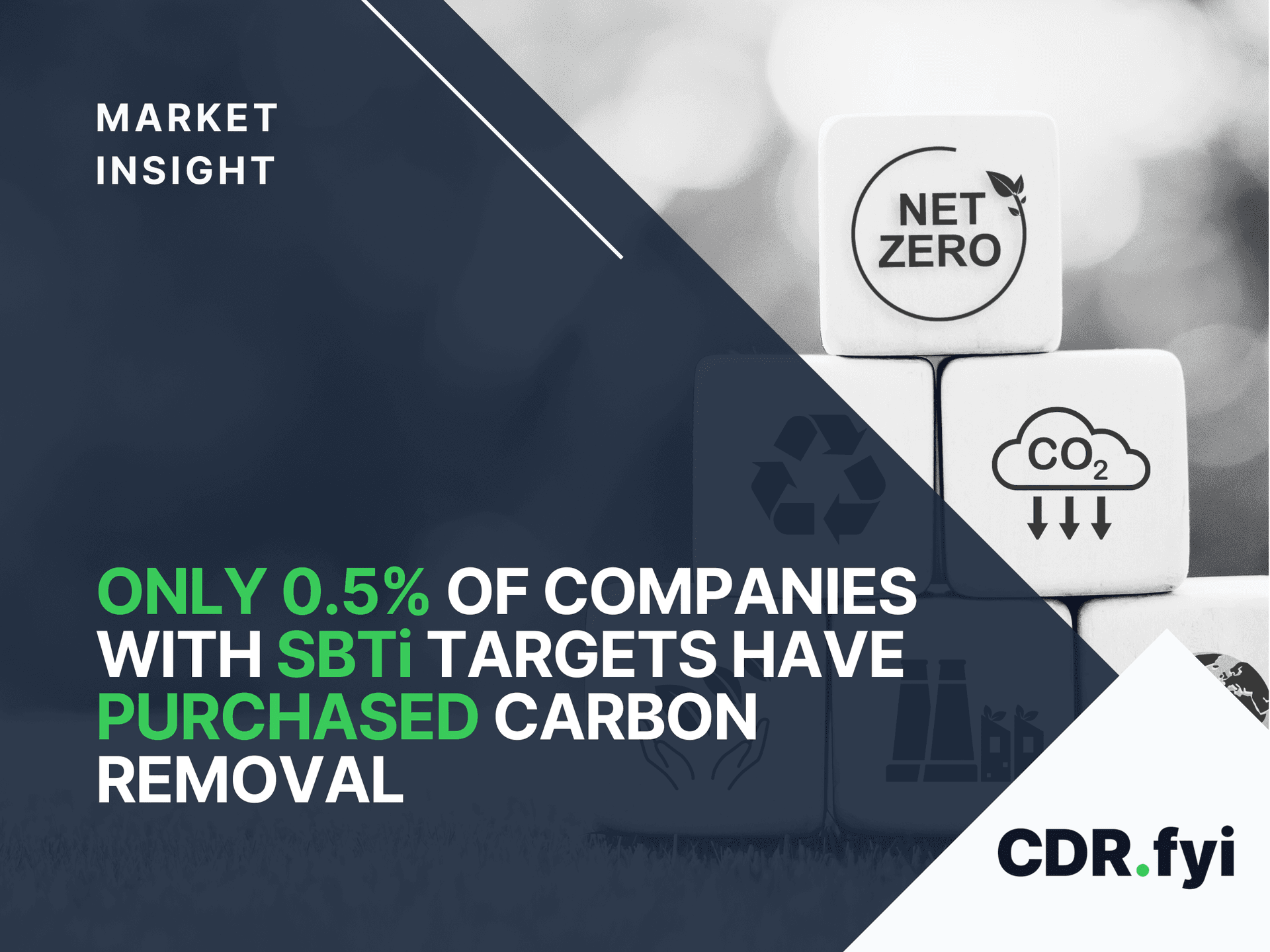September 21, 2023
Only 0.5% of Companies with SBTi Targets Have Purchased Carbon Removal

Only 32 or 0.5%* of the 5,998 companies that have committed or validated Science-based targets have purchased durable carbon removal, according to our analysis at the carbon removal market platform CDR.fyi.
There is a great need to start scaling the carbon removal industry now. All companies need some level of carbon dioxide removal (CDR) to reach their net zero targets, but today, only a handful are taking on the responsibility to grow the sector.
Last week BCG published an analysis of the market for permanent CDR. They project that voluntary buyers with deep pockets are expected to continue dominating the market until the end of the decade, reaching 40-200 Mt CO2/yr by 2030. After this point, they suggest demand will outpace supply, and the compliance market will begin to take over.
The long-term needs for carbon removal are hard to precisely estimate, but even the most conservative estimates put it at billions of tonnes by midcentury. Reaching 40 million removed tonnes by 2030 is likely on the lower end of what is needed to be able to reach gigatonne levels by 2050.
CDR is a new industry, so we are starting almost from scratch. In 2022, only 45,500 tonnes of durable CDR credits were delivered; this would need to grow almost 1000x in 8 years to reach 40 Mt in 2030. That sounds like a bizarrely high growth rate, but it’s far from impossible since several companies are already planning facilities with megatonne annual removal capacity.
Today's purchases of future tonnes are much larger than deliveries, but those are offtake agreements that will be delivered over many years. For delivery by 2030, tonnes need to be ordered by 2026-2027 at the latest.
To finance new facilities, suppliers need multiyear preorders, not just single-year purchases. Government support certainly helps but is not a way out since it almost always requires some type of cofinancing, true even for the new US DAC hubs. To enable 40 Mt in annual capacity by 2030, the total value of offtake agreements signed in the 2020’s would likely need to exceed 100 billion USD and 400 Mt. So far 4,78 million tonnes have been ordered according to our data. A 100x growth in offtakes this decade seems within the range of possibility considering that sales are on track to 10x from 2022 to 2023.
One way to achieve this would be to have 4000 buyers ordering on average 100,000 tonnes for future delivery. So far only 6 buyers have bought over 100,000 tonnes and 10 more have bought at least 10 000 tonnes. The number of big buyers needs to increase by several orders of magnitude.
The risk is not just that CDR fails to grow fast enough but also that the ecosystem shrinks and innovation is stifled. Buyers play two roles: scaling the market, and expediting innovation that helps construct a diverse supplier ecosystem. The second role often entails many fewer tonnes purchased but is perhaps the most important one at this early stage.
The primary challenge for CDR start-ups is to sustain themselves until the demand escalates. At present, there are insufficient buyers to buoy them all, and there are indications a majority of them have never made a sale. However, the start-ups that survive until 2030 have a promising future.
How can we make this happen? A survey in the BCG-report showed that nearly 70% of respondents would ramp up their durable CDR expenditure if guidance were available from scientific or non-governmental organizations. The Science-based Target Initiative in particular (SBTi) plays a critical role in stimulating carbon removal. Even though SBTi mandates permanent carbon removal to reach net-zero targets, it currently offers no incentive for companies to finance carbon removal before net zero. SBTi can demonstrate more leadership by requiring companies to invest in external climate solutions today, so-called beyond value chain mitigation, and clarify that CDR is a crucial part of that support.
Without clear incentives for buyers, sufficient demand is unlikely to materialize.
*The companies with a Science based target commitment (committed or validated) that also appear in CDR.fyi’s database of carbon removal buyers are: Microsoft, Airbus, All Nippon Airways, AFRY, Boston Consulting Group, H&M Group, Block, Inc., Nasdaq, Inc., Zendesk, TravelPerk, Audi (Volkswagen AG), Thermo Fisher Scientific Inc., Vestre AS, Bayer AG, Axfood AB, Bennetts Associates, Samsara Inc., Stanhope Plc, Svenska Handelsbanken, Suomen Yliopistokiinteistöt Oy, GoCardless, Sparebanken Vest, Dalsem BV, WHEB Asset Management LLP, Boom Supersonic, The Economist Group, Zurich Insurance Group Ltd, McKinsey & Company, Inc (through Frontier), Oxwash, Mentimeter AB, plus Avanza Bank and BioGaia AB that supported carbon removal through the Milkywire Climate Transformation Fund/WRLD Foundation. Twenty-two of these companies are in Europe, one in Asia, and the other nine in North America. Nine are SMEs.
CDR.fyi is the largest open data platform dedicated to high-permanence CDR monitoring. Our goal is to equip market participants, policymakers, consultants, academic researchers, and capital allocators with up-to-date, accurate data on the CDR industry to guide investment and help scale this important component of the climate equation.